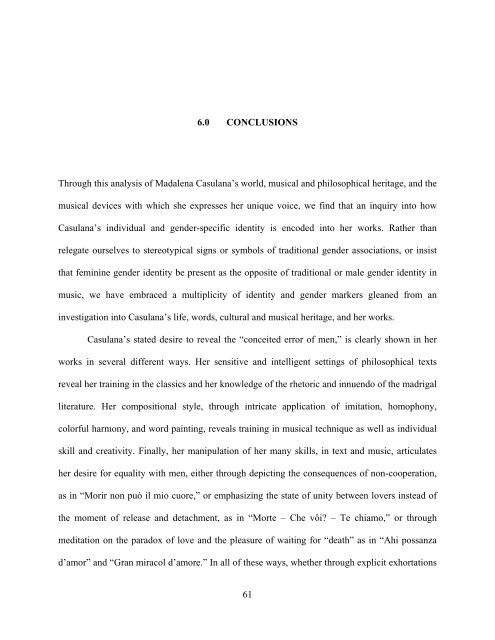Download - D-Scholarship@Pitt - University of Pittsburgh
Download - D-Scholarship@Pitt - University of Pittsburgh
Download - D-Scholarship@Pitt - University of Pittsburgh
Create successful ePaper yourself
Turn your PDF publications into a flip-book with our unique Google optimized e-Paper software.
6.0 CONCLUSIONS<br />
Through this analysis <strong>of</strong> Madalena Casulana’s world, musical and philosophical heritage, and the<br />
musical devices with which she expresses her unique voice, we find that an inquiry into how<br />
Casulana’s individual and gender-specific identity is encoded into her works. Rather than<br />
relegate ourselves to stereotypical signs or symbols <strong>of</strong> traditional gender associations, or insist<br />
that feminine gender identity be present as the opposite <strong>of</strong> traditional or male gender identity in<br />
music, we have embraced a multiplicity <strong>of</strong> identity and gender markers gleaned from an<br />
investigation into Casulana’s life, words, cultural and musical heritage, and her works.<br />
Casulana’s stated desire to reveal the “conceited error <strong>of</strong> men,” is clearly shown in her<br />
works in several different ways. Her sensitive and intelligent settings <strong>of</strong> philosophical texts<br />
reveal her training in the classics and her knowledge <strong>of</strong> the rhetoric and innuendo <strong>of</strong> the madrigal<br />
literature. Her compositional style, through intricate application <strong>of</strong> imitation, homophony,<br />
colorful harmony, and word painting, reveals training in musical technique as well as individual<br />
skill and creativity. Finally, her manipulation <strong>of</strong> her many skills, in text and music, articulates<br />
her desire for equality with men, either through depicting the consequences <strong>of</strong> non-cooperation,<br />
as in “Morir non può il mio cuore,” or emphasizing the state <strong>of</strong> unity between lovers instead <strong>of</strong><br />
the moment <strong>of</strong> release and detachment, as in “Morte – Che vôi? – Te chiamo,” or through<br />
meditation on the paradox <strong>of</strong> love and the pleasure <strong>of</strong> waiting for “death” as in “Ahi possanza<br />
d’amor” and “Gran miracol d’amore.” In all <strong>of</strong> these ways, whether through explicit exhortations<br />
61















